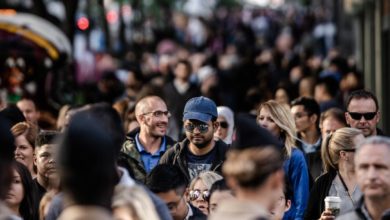Commentary: Looking at the ingredients that cause violence

BY JASON SCHIFO
So, I was sat at the kitchen table watching anxiously. Age and wisdom told me that there was a problem brewing, but I also wanted to allow room to fail so he could learn. After what seemed like a parental eternity, he said, “Dad, this batter doesn’t look or taste right.”
The moment I prayed for had happened. It was time to intervene, and unlike many other times, I didn’t jump up and tell him how it should have been done, or how wrong he was for doing it the way he did. And he didn’t get defensive. We just went down the list of ingredients one by one, looking at each one, making sure we understood why it was there and how much was needed so the finished product would serve others well.
When I think about that story it serves as a kind of parable for what we are facing today…
The Gifford’s Law Center has reported that an average of 36,000 Americans are killed by guns each year, an average of 100 per day. In 2017, gun deaths reached their highest level in at least 40 years, with 39,773 deaths that year alone. This was an increase of 16% from 2014 to 2017. But we don’t need statistics to catch our attention and raise our concerns. We have the recent events in Dayton, Ohio, El Paso, Texas and others to inform us.
Certainly something needs to be done to address the sharp rise in deaths between 2014 and 2017 (and 2018-2019), but my caution is that we need to address every part and ingredient in this recipe as important to the whole, and not focus on just one, so we like my son, don’t miss anything.
Here are, from my perspective, the ingredients:
Lack of Empathy:
Studies have proven that we suffer from a growing lack of empathy. The sharp rise of communication through impersonal means (devices) and at a distance has created a rise in a lack of empathy for others.
No longer do we look people in the eye and discuss our differences with them. No, now we just simply type, tweet, post, blog, live stream and then hit send, with no degree of empathy attached to our actions. I believe that any communication that is done without having to look at another person in the eye tends to lack loving empathy.
A Lack of Real, Meaningful Connection:
In one sense, we are more connected than ever. We have access to one another’s lives through posts and pictures, at all hours of the day and night. However, as one cultural researcher has said, “our connections have become window dressing, lacking any part of what makes meaningful connection truly meaningful.”
Think about it. People are friended and unfriended, brought into or blocked out of conversations on a whim. Our connections are no longer heart level, but instead, are often now dictated by the swipe of a finger. Our meaningful connections with one another cause us to depend upon and care deeply in meaningful ways for others.
Spending Time Alone, Together:
One of the saddest things I read recently was Robert Putnam’s book “Bowling Alone”. In it, Putnam talks about a growing trend of people doing things alone that they traditionally did in groups. Things like: eating alone, seeing movies alone, and even bowling alone, an activity that was once considered the gold standard for group activity.
The saddest part of Putnam’s conclusion is that our aloneness is often happening in the places where it shouldn’t, where we are together. We may be “bowling alone”, but we are still gathered together doing it. And in being alone together, we are robbing ourselves of a key component to being emotionally healthy: being known.
So a lack of empathy and meaningful connection, in a growing culture being alone and unknown is the recipe thus far. Now, let’s add a few more ingredients:
A Lack of Justice:
I remember being a teenager and watching with everyone else the trial of O.J. Simpson. I also remember a deep sense of frustration as I watched the verdict being handed down. The glove may not have fit, but there was too much evidence that did fit to deny the truth. They said justice was served that day, but it was half baked.
And this isn’t an isolated case. It seems like daily we are served stories where justice fell short, falls flat and isn’t being served. We watch people who are clearly guilty, who never answer for their crimes. You don’t have to look too hard to see injustice at every level, and it is maddening.
Video Games:
The video game market, according to Newzoo, is growing rapidly from $137.9 billion in 2018 to projected $180.1 billion by 2021. The research firm also expects the top five video game markets in the world to generate nearly $98 billion in revenue this year alone. I stand by the old adage, “follow the money and you will find the problem”, and I’ll also add, “if there’s enough money, then you will find the reason why we don’t address the problem.”
Of the video games on the market, the top-selling games by percentage and revenue are first-person shooter games. There is something powerful about assuming the role of someone who has the power to solve problems, save the princess, address evil and injustice, and defeat the enemy. I would argue that these games have gotten so realistic that the lines between fantasy and reality have continued to become blurred. At what point will it become indistinguishable?
According to Jordan Shapiro writing for Forbes, “if gamers spend much of their time in virtual game spaces, averaging 22 hours per week, in the United States, it will shape their worldview.” Shapiro goes on to voice his concern for his own sons as they “see that the world is not just a landscape full of potential targets.”
“I’m just saying,” he recalls saying to his boys, “I watch you playing Halo, and I want to make sure you know that when you grow up, work will not be all about locking onto problems that can be eliminated by choosing the right weapon and firing with simple solutions.”
Friends, a lack of empathy, meaningful connection, being alone and unknown in a culture of injustice, while being trained to act upon our convictions is just missing a call to action.
Media Antagonism and Toxic Sensationalism:
I am old enough to remember when the news was someone sitting at a desk, with a few pieces of paper, reporting the news to us. These days news is inundated with sensational graphics, animations, heated debate, sharp rhetoric, and even inappropriate images – all to keep us tuned in. And not just for 30 minutes a night, as it used to be. Now this kind of news runs 24/7, across dozens of channels, day and night.
News today relies on creating a growing sense of antagonism and tribalism by sowing division between issues, peoples, parties, and platforms. It isn’t about expressing our differences and differing views in healthy ways that move us towards truth together. Now celebrating and vilifying the rightness or wrongness of groups in sensational ways is part of the standard playbook. And honestly, I really don’t see much difference between that and reality television.
Jordan Peterson recently said of technology and media: “Traditional media is in a difficult place right now. Podcasts and social media have become the go-to for people to get information and opinion. In terms of traditional media and news, there is an extinction-level event coming. The signs of that are found in the ways media now has to sensationalize itself to attract viewers. In effect, waving their hands in the air and saying, ‘look at me.’ This form of sensationalism is toxic.”
I believe this type of media is especially dangerous for those who are already at a tipping point. Those who are not connected in meaningful ways and feeling alone and unknown.
Mental Health and Over Medication:
Mental health is a real issue, and one that we need to address, but what I am not hearing enough about in connection to mental health is over-medication.
Graham C.L. Davey Ph.D. writing for Psychology Today says, “We hear so much about mental health problems. But the most recent figures tend to suggest that as many as 57% of people with mental health problems are being treated solely with medications and without any form of psychotherapy. And that figure is not going down, it’s going up from 44% to 57% between 1998 and 2007. In addition, the pediatric use of antidepressants has risen significantly between 1994 and 2000, largely to treat childhood anxiety and depression, and has often occurred without regulatory approval to the benefit of the drug companies.”
Let that last line sink in.
Davey goes on to say, “Treating mental health problems with drugs from the outset may effectively “medicalize” them, turning what might have been short-term acute bouts into a longer-term chronic problem. For example, almost everyone knows someone who has been on anti-depressants for most of their life. This may be good business for the pharmaceutical industry, but are those drugs having any significant effect on symptoms and the users over the long-term?”
There is big money in medicalizing the problem rather than addressing it properly with empathy and meaningful connection in ongoing therapy. But there is a roadblock. In many instances, insurance providers will only allow 6-8 appointments with a licensed therapist. Unfortunately, 6-8 appointments are only the beginning of what is needed to help unravel the problems most people face.
Deputy John Miller testified before congress on gun violence saying, “These kinds of stories (Dayton and El Paso) don’t create new stories, they accelerate the ones already in motion.” It tips over the ones who are already at a tipping point.
We need to address mental health, but not only with medication. We need to grow in our empathy, seek meaningful connections, finding those who are alone and unknown and meeting them where they are at rather than medicating them.
Now, probably the most divisive thing I will say comes next.
I want to preface my comments by saying I am neither pro-gun nor anti-gun, don’t own any guns, nor am I a member of any gun-related organizations.
Guns Alone Are Not The Problem:
I am not dismissing guns from the equation, and I believe that they have a place in this problem. But the gun is a tool, an expression, used to work out what is happening within a person. Take the gun away from gun violence, and the violence still remains. I personally believe that without guns people will just pick up another tool to work out what is at work within them.
Prior to gun violence, we had bow and arrow violence, sword violence, club violence and even before that stone violence. It is the way that humans have done it since Cain picked up a weapon and slew his brother Abel. The issue is not the tool per se, but the person who holds the tool responsibly and in the right regard. Sure we can remove guns, but then what else?
Instead of passionately trying to remove something, why not put our passion to work in things like showing and growing in empathy? Seeking meaningful connections with others? Not allowing the alone and unknown to remain alone and unknown. Realizing that the most valuable resource we have is sitting next to us.
We have to be bold enough to challenge industries to act responsibly with their products, not allowing revenue to trump responsibility. We have to hold power accountable. And we have to stop looking for band-aids to big problems and start finding solutions around kitchen tables in our own houses, rather than hoping it might come from the White House.




